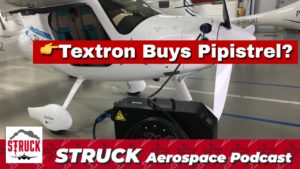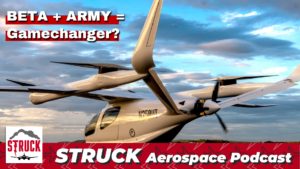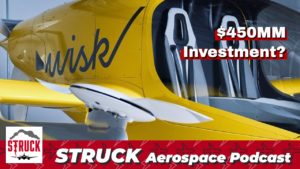How do we eliminate flammable fuel vapor in transport aircraft fuel tanks? Equipment like the Parker fuel inerting system – OBIGGS – and Air Separation Modules fill the ullage space with inert nitrogen gas.
The Pilatus PC12 was a game-changer. Is the PC24 business jet headed for the same level of success?
Cirrus Aircraft introduced the airframe parachute system on their SR-20. With the new Vision Jet, Cirrus and Garmin take safety to the next level with the Safe Return System. Check out the Safe Return System in operation via YouTube – https://youtu.be/JvzPpOknjME
Learn more about Weather Guard StrikeTape segmented lightning diverter strips. Follow the show on YouTube, Twitter, Linkedin and visit us on the web. Have a question we can answer on the show? Email us!
Podcast: Play in new window | Download
6:20 Parker Aerospace’s inerting systems
17:57 The Pilatus PC12 and PC24
23:58 Lightning and turboprop engines
25:49 Cirrus parachute and Safe Return system
33:13 Garmin makes awesome products
Transcript:
Struck EP6
Dan: Hello, welcome back. This is the Struck podcast, episode six. I’m your cohost Dan Blewett, and here on the Struck podcast we talk about everything, lightning protection, aviation and aerospace tech. And I am here joined remotely by lightning protection expert, Allen Hall. Allen, how are you?
Allen: Great. Dan, how are you doing?
Dan: Doing well, so. A lot of new things going on this week. I got a new mic on the way, so ordered some new parts for my podcasting set up here. I got this huge, like dr octopus, um, like at home set up, which is pretty intense. Um, what’s going on with you up there?
Allen: Uh, well, we’ve been through a couple of snowstorms over the last week. Uh, everybody is still quarantined for the most part. They canceled school for the rest of the year. Uh, how’s everyone feel about that? Not happy, not happy at all. Uh, all the, the kids are just missing being with the kids and the teachers are trying to work, uh, classes through zoom and, or other video formats, and it’s just not the same. And so the kids. Are really struggling with the lack of sort of one-on-one or a groups with the teacher interactions. I’m just trying to get homework done. The other thing that he announced, it’s, it’s all pass fail. So the kids don’t have grades like they would normally, and my daughter’s a junior so. This is sort of like the year you need grades to start applying to schools and no one showed her and the SATs have been shoved off and it’s just, everything’s in chaos right now. Um, so that’s, that’s, uh, an unusual twist cause I didn’t think the sat would get shoved off like that, but it, it did, it got pushed off until then, until the fall.
And then the other thing that seems like it’s happening is a lot of the colleges and universities. Or not worrying about sat scores. So they’re just saying, apply with what you have, which is going to be, it’s going to be an interesting curve that’s just going to be on, uh, for the next couple of years to see how that all plays out.
We’re not going to know, obviously for several years to see what happens there, but, um, kids not going to class all the time and, and just know a couple of teachers in different parts of the country. And. They’re having trouble with the kids showing up on the, on the video, uh, video links, like someone that just don’t show up and what are you going to do?
There’s really, you can’t force them to show up. Right. So if they’re not going to show up, they’re not going to show up. Yeah. It’s unfortunate because the kids are really missing out on a good opportunity to learn. You know, if you’re sitting at home in bounds, we’ll be learning something. Yeah, we’ll see.
Well, they’re probably Googling things, if that’s any consolation. Tick tock, tick tock you tubing a, yeah, yeah, yeah. Or learning how to, I mean, there’s so much weird stuff on Instagram, like interesting stuff. I watch. Little clips of manufacturing and woodworking and like machining. So they’re all probably learning lots of useless little things that are just so there are useful things like what if you stuck in the woods and you need to Willie yourself a canoe to swim downstream.
You know what else you going to learn that ad side YouTube. Exactly. Exactly. So. You’ve got some news, you’re in a new, a new studio as well. So tell me about your new space. So we’re moving into a new manufacturing space. Uh, everybody’s frantically, uh, putting the space up. Uh, we got contractors coming in.
Individually, so they’re kind of coming one at a time because of the Corona virus situation. Um, power’s in, uh, plumbing is in, uh, we’re working on carpeting. Uh, equipment’s coming its way, so everything’s coming in. It just delays because of ways things are getting shipped and everybody’s just tied up on all the truckers are all tied up so.
It’s, it’s taken a little longer than we thought it was going to take, but it’s actually coming together quite nicely. Again, as part of the move, I actually have a podcast space, which is super because they have been wanting to do that for the last couple of months. I’ve been waiting to get in here, so we’re going to make some changes too, and we’ll probably have your setup quite honestly. We’ll have your set up of equipment in here and yeah, that’d be nice. Finally.
Dan: Yeah, it’s, it’s, it takes some doing, but it’s definitely nice to just be able to kind of like hit a couple buttons and just reach from where you’re sitting and just be ready to go. Yeah. It’s, uh, it’s every, every little kid’s podcasting dream, of course, which is, which is funny that I say that because podcasting is such a ubiquitous thing now that. There might be a little kids that want to be podcasters when they grow up. Isn’t that a weird thing to think about, but I mean, a lot of them, yeah, it’s right.
Allen: It’s radio now. It’s exactly. Radio. Radio has died. A slow death and everything is either gone to satellite or gone on to podcasting. Yeah. Yeah. I haven’t listened to radio in so long.
Dan: I mean like why would I, who would listen to radio? I mean. Yeah. You don’t feel some merits, but yeah, so through commercials, they’re curating music for you.
Allen: It’s sort of civilization. You’re in a big, you’re in a big area where there’s a lot of radio stations, Washington, D C there’s a plethora of radio stations where we are.
There’s one that’s close by. You can actually get, and you can only get it if you’re in the Valley, which the antenna is. So there’s not a lot of, just not a lot of radio stations to choose from. And even that. That one is struggling because people don’t listen to it anymore. Yeah. Podcast. Yeah. The way to go. That’s the way to go.
Dan: So in today’s episode, we’re going to talk about a bunch of different things. We’re gonna talk about inheriting systems a little bit, um, some of the things that Parker aerospace is doing. Um, and we’re also gonna talk about a little bit lighter aircraft. So some of the things that Cirrus and Platas are doing, so they’ve got some interesting stuff, and I’m curious about some of their lightening protection.
And how, how it changes from jet to turboprop and also largely commercial aircraft to small, um, you know, more of the personal, private jet kind of aircraft. So, um, let’s start with Parker. So obviously, you know, we’ve mentioned in past episodes, and I’m sure we’ll continue to talk about this, but the, uh, the fascinating in earning system, which is not fascinating maybe to you because this is like things you’ve been doing for many, many years.
But I don’t think most people as they fly in a commercial airline are realized that. There’s this system that’s pumping inert gas into the, uh, fuel tanks as they empty to keep them safe. Like, that’s a crazy, that’s like a kind of a mind blowing thing, um, for someone on the outside. But tell us a little bit about Parker, what they’re doing and how some of those alerting systems work.
Allen: Yeah. So Parker, uh, has had developed an earning systems a long time ago for military aircraft back in the 1970s, early eighties, is when I think that was first developed. And the, if you think about, um, a wing as being a fuel tank in your car, it’s exactly how it is and how it’s, it’s sort of integral with the structure.
So the wing structure is the tank. There’s no separate structure inside the wing to hold fuel. For the most part. Uh, so the, the, the rivets you see on the outside of the wing penetrate into the inside, and then there’s this fuel right behind it. So they’re just the lightest solution to low fuel. Well, as you burn off fuel, you have this, this airspace.
Uh, above the fuel and as you slosh around fuel and depending on temperature, you’ve got fuel vapor up in there. And if the conditions are just right, tends to be above 75, 80 degrees and certain pressure thresholds that vapor is flammable. So any kind of small spark could in theory lead off that that fuel vapor, and when you ignite any sort of gas as fuel like that, it wants to expand rapidly.
So what in theory would happen if it did ignite it, but it over pressure. The wing structure and break the wing structure, and that would be catastrophic. Uh, so the, the Parker aerospace system, which is really ingenious, quite honestly, what it does is it takes bleed air from the engine. So as the engine, the jet engines spool, that there’s compressed air, that’s.
Forced them to the engines, essentially. Um, it’s the same air that pressurizes of the cabin. So as you’re sitting in and you’re a three 20 or seven 37 or bigger aircraft, what you’ll see, and you know, you’re flying it at a theoretical, I think it’s 8,000 feet, is what it feels like inside the cabin.
They’re actually taking air from the engines and pushing that into the cabin to pressurize the cabin. Will they take some of that air and they shove it through a filter? So they take that that air in the air is mostly nitrogen. It’s like 80 20 nitrogen to oxygen is about 20% oxygen in the air. They put it through a filter.
No moving parts, just a think of this just as a filter. And the nitrogen molecules tend to go one way and the oxygen molecules go the other, and then what they do is they take the oxygen and they just going to dump it overboard and they take the nitrogen rich air and shove that into the fuel tank. And what that does is it basically forces the vapor out and makes it such that the vapor that does exist there won’t ignite.
And it’s a beautiful system because it involves essentially no moving parts. So it’s extremely reliable and it’s, it’s a, it’s a very simple conceptual system, but it’s also functioning very, very simple too. And it’s, it’s, it’s been honed over time such that the units have gotten smaller and more efficient, and we know a lot more about fuels, quite honestly, and, and how to integrate the thing until the end, until the airplane.
Um, so the, the Parker system. And then there’s usually two big names with it. Oh, bigs, which is onboard a annuity and gas system. And then the other one was air separation modules. So they have a separation module is a place where the, the air is separated. So the oxygen and nitrogen, uh, those, the, that’s the, the key feature to the whole thing is that our separation module, and you can actually watch on YouTube, they actually show you how they make that.
It’s a bunch of very fine. Uh, fibers that are shoved into a canister essentially. And they just push air through it. It’s brilliant and it’s totally changed the way we address fuel tank safety cause it adds a whole level nother level of safety on fuel tanks. And after the 80 a hundred. Um, and flight, uh, explosion of the seven 47 back in 1996 I think that’s when it was.
Dan: Yeah, I think that’s right. 96.
Allen: Right. His off is going from, I think, New York to Europe, if I remember correctly. And they had just left Newark or JFK or LaGuardia, one of those airports on the East coast and was heading off. And it, it, um, it had, uh, some sort of an arc in this, in the fuel tank, they think, and it exploded.
And it. It just, that accident totally changed the way we thought about fuel tanks. And just from there on out, the rules changed such that we have to assume, uh, uh, there is ignitable vapor in the tank. We have to treat it like that and we were going to put in a herding system and get rid of it. And on the same hand, on the same token, we also want eliminate all potential sparks sources in the tank.
And we do analysis to show that we don’t have sparks horses and that those sparks sources. Uh, there’s, there’s protection features, actually two levels of protection features before you could get to a spark source. So a lot has changed in that Parker system. Has really made aircraft substantially safer than they ever have been.
This is the safest era of flight that has ever existed, and it probably one of the safest modes of transportation that has ever existed with these fuel nerding systems and all the advanced features on an aircraft today. It’s, it does make aircraft way safer than they have been in the past.
Dan: Yeah, it’s a really interesting concept because, uh, you know, I, I used to work on cars.
This is like a, you know, a hobbyist mechanic when I was. You know, in high school and you know, you start to think of how to tune your car and to obviously get more horsepower out of your car. And I had a 67 Bronco. You’re trying to find ways to inject more oxygen into the, you know, in the, into each cylinder.
So that then, you know, the carburetor and I guess now this, the electronic fuel injection systems, they will then up the amount of gasoline that they’re gonna. Pump into there. So they have to, you know, obviously everyone knows that cars operate efficiently when they have the right fuel air mixture. Right.
Um, and here we are using that same thought process to keep, you know, if it works in reverse, reverse. Exactly. Take the auction away from it and store it. Yeah. Yeah, yeah, yeah. So it’s a clever system. So, um, we’re going to segue a little bit into smaller aircraft, but my first question there is, do, is this only a feature that large commercial aircraft have or do some of these smaller planes, like we’re going to talk about Cirrus and Platas, do they have systems like this or is it not a big enough deal for them? Or what’s the story with smaller aircraft and hurting?
Allen: Depends on what the wing is made out of. For the most part, and whether they have separate fuel tanks that could be empty over time. Uh, so fuselage, fuselage, fuel tank. So sometimes the, the, the, the tanks are broken up into sections. Um, so if they’d have, and, and the issue with the seven 47, the TTB 800 was, it had sent what they call center fuel tanks.
So the fuel tanks along the fuselage underneath the fuselage that typically ran empty. And then the wink tanks are usually full. It has to do with weight and balance and a lot of different. Things there, but so, um, smaller aircraft don’t tend to have compartmentalize fuel tanks. There is on a business, jet is, it says B, left wing, right wing.
And then sometimes there’s a, there’s a, uh, fuel tank behind the pressure vessel in the backend. That tends to be a very common setup for business jets. Um, if. If you think about it, it has to do with temperature and, uh, sorta history combined with it on a metal wing airplane, the fuel gets cold so pretty quickly.
So there’s not a lot of heat in it. And you need heat, uh, to create the vapor. On a composite or a plane made out of carbon fiber, fiberglass, what are we going to make out of the, make the wing out of the heat transfer out of that is not nearly as good. So as the engine turns, uh, it’s actually putting hot fuel back into the, into the fuel tank, and that hot fuel can create, eventually create vapor.
So the temperature. The temperature rise inside of a composite wing is higher and it tends to stay around longer. And a metal wing where the airflow is going over the aluminum wing all the time, it tends to cold soak it and keep it where it’s not flammable. So it depends on what. Um, so there’s two pieces to it.
One depends on where the fuel tank is and to, uh, what the main wing is made out of. Is it metal or is it carbon fiber that determines whether you’re going to have an alerting system? So when I worked on the Lear 85. For Bombardi a and in, uh, Wichita. We had an, it was a composite wing carbon fiber wing, and we had an earning system in it.
And I think the same thing exists on the eight to 20, which was the Bombardi AC series. It also has a carbon fiber wing, and I do believe it has a Parker and herding system inside of it. Um, so it really depends on the configuration. So metal airplanes don’t tend to be business just don’t tend to have that, uh, bigger airplanes with sinner. Fuel tanks tend to have an herding systems in them.
Dan: Yeah. So quick question about that. So, you know, when you’re designing a new aircraft, you know, you have a bunch of smart men and women in a room and you’re discussing, okay, here’s the wing. What do we do? What do we put in this, you know, to keep this fuel system safe?
Do we need an energy system or don’t we, um, you’re making all these decisions with a plane that’s never flown. So how do you know that? I mean, obviously there’s a lot of people involved in checks and balances and. But how do you know that that was the right decision? Like your plane doesn’t go up and just blow up.
Allen: So the regulations for that are very specific. There’s a rule 25 dot nine 81 that’s very specific about the requirements for nerding systems, and there’s a, there’s a number of advisory circulars that go along with it and guidance material, and there was a ton of effort of publications after the TW 800.
Which, so the publications tied with advisory circulars tie with a rule, tell you whether if you need an earning system, whether it’s required or not. Now there’s also the trade off of the marketing part of that, which is you may not need it by regulation, but do you want to put it on there? Because it’s a safety feature.
That’s when it gets a little more murky because a lot of aircraft have them. And a lot of bigger aircraft have them do. Why put it on my larger business jet? That’s a good question. Um, it’s hard because you’re going to trade the trade off is you’re going to add the system. There’s obviously complexity to a system regardless if if, if the Parker system is very most simplistic.
Operational system you install. Uh, but you know, there’s things in a bit that could fail over time. And then the added weight, what do you want to add? The weight to the aircraft versus the probability that’s, that’s always the trade off. So yeah, you, you have, you look around the room, you say, can we afford the weight?
Can we afford the expense of it versus the probability that something wrong is going to go, it’s going to happen. That’s the trade off you make. Yup.
Dan: Gotcha, gotcha. So, um, let’s, let’s talk a little bit about, uh, some of these specific smaller aircraft makers. So politesse, um, spend a bunch of time checking out some of their jets, um, some other turbo props. So what are some of the unique things that politesse is doing right now?
Allen: The Platas PC 12 was a game changer in a lot of ways. Uh, it’s a single engine triple prop airplane. And so what it did is it took the advantages, and it’s a Pratt and Whitney turboprop. They took the advantages of Trover props, which is just extreme high reliability that they’ve been flying trouble props since the fifties probably.
And it’s been, and it’s just been a constant improvement, improvement, improvement, improvement. So if you’ve gone away from two engines like they have on the beach, King airs or, or, yeah, I guess it’s speech now on the King airs, which are two turboprop prop engines to one. And they sent her, lined it. Um, and the way that the Platas the PC 12 works, it’s got a big door in the back, so you can actually put a lot of cargo in the back end of it.
So you have a high reliability, high efficiency, high load capability capability. Aircraft. That’s, that’s a single pilot. I believe that’s a single pilot. Yes. Um, and so it has all these really great features, which is you don’t have to have two pilots in it. You can load it up pretty heavily and it’ll go anywhere.
And what you had seen as pickle, you in places where it was cold, like up in Canada, the PC 12 tended to be a very. PA, Oh, it still is. It’s still a very popular aircraft. So it’s replacing twin engine aircraft, so it has essentially half the fuel burn, but the reliability is still there. Those aircraft just don’t break.
Uh, and that’s key. When you’re flying in the wilderness or the mountains of Canada, the worst thing that can happen to you is the engine stops. Uh, and, uh, pull audits has had a tremendous track record there. Um. They’ve transitioned to making the PC 24 which is a twin engine turbo fan aircraft. Very soon, very similar to a lot of like a citation kind of airplane.
I haven’t seen as much about that aircraft. It’s kind of coming out in a bad time, obviously, because the economy’s in bad shape. But, uh. Only heard good things. The people that have no, that have actually worked on that program like it, they like the aircraft. Now, how that plays out, timing in an aircraft world can mean everything in terms of success.
So if the economy is booming and you get the right airplane at the right time, you can ride that wave, uh, fill your bank account and then write off the down right out the downturns. We’ll see what, how plot plot a should have. Plenty of cash from the PC. 12 had been a very, at least from what I see in the outside, it had been a very reliable company, had always shown up.
They’re always delivering product. They seem to be pretty stable. Uh, but the, the, the quality also of those aircraft sees behind, uh, people I’ve talked to that operated them or have worked on them like them. So they’ve done a pretty good job for not being a very large aircraft company. They’ve done a very good job of delivering a very high quality product.
Dan: So what are some of the challenges, um, for Platas, and this is not obviously exclusive to Platas in any, any means, but also Cirrus and some of these other smaller aircraft, but what’s, what do they have to do to protect, um, a small aircraft from lightning strikes? Well, the Platas is mostly aluminum. Uh, some of the Cirrus, like the Cirrus sr 22 type airplanes are twenties, are fiberglass.
Allen: Uh, totally different animals in terms of lightening protection. Uh, the, the, the, the Cirrus has, uh, expanded metal foil on portions of the aircraft of number correctly. I think there’s pathways. It isn’t like the whole aircraft is covered in foil. Um, so they provide pathways for lightning to travel down this, these foils and this internal metal structure that he had built into the aircraft.
Uh, uh. Politesse is essentially a metal airplane. Uh, so there’s not a lot of things done there because it’s, it’s sort of inherently safe. It has, it’s probably as good as it’s ever going to get so that the, the design philosophy is about those two aircraft are completely different. Now. You’re going to spend a lot more time.
And a lot more money and a lot more energy on a Cirrus type aircraft, getting it certified and you know, like their new vision jet, which is a beautiful aircraft. Um, and it’s also a composite airplane. Uh, surely spent a good bit of time and money trying to get that thing certified. Um, whereas if it’s going to scoff and certify a, basically a Cessna one 72, one 52 type metal airplane would be a lot easier to do.
Dan: Yeah. So, so does the, the shape of, cause obviously I own a commercial jet, you know, the, the nose Ray dome is composite, so that needs a lot of protection. But what about the, the nose of these aircraft? Do they have a lot of uh, radar equipment in there? Do they have non, like what’s an obviously the, the more steeply cone shape they are, that’s going to affect the charging, isn’t it?
Allen: Yeah. Like the PC 24 has got a pointed nose rhino on it. it all involves. The expense of the aircraft and how fast it flies, how far it’s going to fly, whether you end up having a weather radar or not. Now, garments made a very small weather radar. They can put in a lot of different places that’s unique. Um, so it’s actually giving a smaller aircraft the ability to have a radar, which probably they couldn’t have had before.
And there’s a lot of. Oh, um, sort of wireless radar systems are just pulling off data and it’s displaying on a radar display. So it’s not live. It’s just data like we would watch on television and watching the weather channel. It’s just kind of displayed on, on some flight systems there. Um, but the, the, the radar for like the PC, uh, 24.
We’re going to get charged a lot is because the airplane’s fairly good size. So you’re gonna see a lot of charging issues. It’s going to be a totally different beast from going from a, a Tober pop PC 12 to a PC 24 so you think, and same thing for the sr 22 Cirrus sr 22 aircraft, which are propeller driven aircraft, go into a vision jet sort of thing where it has a nose rate.
I’m on it. The lightning. The way lightening attaches to those airplanes, the protection you got to put on the on the radar is going to be completely different than what they’ve ever done before. So it’s a, it’s a new, it’s a new thing for them.
Dan: And the turbo prop engine itself, I mean, is there any issues with the lightning?
Lightning hit a propeller into the engine itself. So how does that. Not, I mean, that seems like crazy risky, but it is, apparently they’re very safe. So how do they, how, how do you work that out?
Allen: Well, the, the, I’ll give you the, the King of example, because I worked there for a couple of years. Uh, the King airs get struck on the props quite often, uh, just because of the, at least on the, on like the, the.
The B 200, um, the three 50 gets a little bit longer nose, and so the nose can take more strikes, but on a lot of those kind of mid, mid level, uh, turbo props, the props are the most prominent feature. So the profs gets struck and that forces energy through the props into the main part of the engine, through the bearings.
And it’s the bearings that everybody worries about. So you got this. Yeah, huge compressor system that’s spinning on these very expensive bearings. You have to go in and tear the engine apart, inspect the bearings at the bearings are good. You put them back, but most likely they’re not good, so you’re going to.
Pull the bearings out, but fresh bearings back in it put the whole engine back together so it involves complete tear down of the engine, usually as part of the lightening inspection of the aircraft. So you don’t want to fly around. Then there’s no need for a King air to be flying around thunderstorms, especially since it has a radar in it.
Um, it’s had radar forever, so you should be able to avoid thunder storms in a King and a plus. It’s just not fun to fly in. I’ve been in a lot of King here. I spent a lot of times in Kinko’s and you don’t want to be flying around convective activity if you can avoid it. So, uh, it’s expensive when a King ever gets struck.
It’s also bouncy and a little bit scary when that happened, just being around the thunderstorm. So it’s just best to avoid that under storms all together.
Dan: Gotcha. Gotcha. Um, so let’s, let’s shift a little bit to Cirrus. So what’s unique about some of their aircraft and what, what are they on the cutting edge of right now?
Allen: Aerodynamics, uh, and safety. They’ve always been there on the aerodynamic side. Uh, yeah. That parachute, that thing is audits. Awesome. That makes me feel like, Oh, I could go fly a plane, maybe as long as I have just like, can deploy the air. You know, the parachute. And they’ve had quite a number of deployments.
I forget what the total number is now, but you can just go on YouTube and see the deployments because people catch them falling from the scar with the parachute landing on highways and things of that nature. Um, but , the parachute system is. One of the early safety features that was in the Sirius, and it, it, it works on a rocket.
It’s, uh, in a parachute behind the passenger area of the aircraft. And there are straps built into the composite structure of the aircraft. So as the rocket shoots up in the parish, parachute deploys, it pulls the straps out of the. The outer shell of the fuselage, we’ll call it, and it ties into the metal framework is in the middle, and that’s those, the lift points for the, for the aircraft, um, and then it just drifts down to earth.
That was a very early selling point for Cirrus, and I think it really set them apart. Obviously you’re going to eat the weight and you’re going to eat the complexity of having that system. And also there’s some, there’s some sort of funky legal things you’d worry about, like if someone deployed it in properly or someone pulled the handle and it didn’t deploy sort of thing.
So there’s a lot of, you know, there’s a lot, I’m sure there was a lot of detail work going into that system. But it’s saved a lot of lives at this point because occasionally a Cirrus pilot will get in the wrong place at the wrong time, or they’ll have some sort of medical Capella have a medical condition and that, you know, a passenger will pull the parachute and land the thing, uh, essentially destroys the aircraft, but you can walk away from it.
That’s huge.
Dan: And
really why does it, why is it destroyed the aircraft?
Allen: Because it’s actually pulling parts of the fuselage apart and it’s, it’s it, it’s, it uses it the landing gear, which are always out, and it uses the landing gear as part of the shock absorption system. You know, landing gear just can’t take the cause you’re falling at a pretty good rate still with the, even with the parachute still falling into a pretty good rate.
So the landing gear kind of gets. Banged up pretty hard and I, and it’s just not made to take that, those, those stresses, because it’s not necessarily, you’re not landing on soft cushiony pillows. You’re probably landing in a very Rocky area or a very wooded area. So the airplane is going to get beat up as it lands in that.
Yeah.
Dan: And then you gotta throw in the trash. That’s so sad.
Allen: The most important thing is to be able to walk away.
Dan: Yeah. Well, yeah. Right.
Allen: A good landing is when you walk away from that’s, that’s the world. And in that case, it’s more important at the end of the day that the airplane is a tool and the tool should not kill you.
Hopefully that’s part of the way we design them and having the added feature of the parachute system. Uh, really adds another level of safety to maybe pilots that don’t have that much flight experience. And it does bring more people into the, like you said, it does bring people into the ability like, Hey, I could fly the Cirrus.
None of them that have advanced avionics. It’s always had great avionics and a very docile handling characteristics, but it’s also got this added thing. Like if I screw up as a pilot, I’m not gonna, uh, you know, kill my family. This thing, we’re all gonna walk away from it. That adds a level of confidence that probably makes a lot of sales for them.
Dan: Unless you consider the aircraft part of your family, in which case it does not
walk away, it dies
Allen: . The aircraft is going to die. Yes. Yeah.
Dan: Put your aircraft in a little cardboard box and buried in the backyard, just like your journal, and maybe have a little candlelight vigil and then go watch Netflix, watch Netflix, and then order some Chinese.
Yes. Well. So speaking of which, uh, Cirrus has another super cool safety feature, um, on their vision jet. Yeah. So tell us a little bit about, there. Safe return auto land system.
Allen: So the, the safe, uh, auto land system, and everybody’s got to go to YouTube and check out this, and we ought to include in the show notes.
It’s an impressive, it’s an impressive video for sure. Extremely well done. And it lays out exactly how the system works because there’s really nothing like it on the market. Uh, and there’s a button in the cockpit just behind the cockpit so passengers can touch this button, but it’s essentially a big red button.
It says. Land to me, you press the button, the autopilot takes over, and that’s a Garmin, uh, airplane. So Garmin does the avionics for it. The system locates the nearest airport, puts out the distress code and flies the airplane to the airport lands. It, stops it on the runway, stops the engine, and you walk out of it.
That is a. Believable engineering feat and to get it certified is even better, uh, because of so much complexity too. Not having a pilot in the loop. First of all, you got to know where you’re flying to. So you could be in the middle of all of, say you’re in the middle of the Hills of the Rocky mountains and you punch this button.
Uh, it has to determine a very safe payer path based on the typology that is around you and the weather. I think for, I think it does check weather. Yup. And then it sorts finding a pathway, and then it’s, it’s, it’s squawking out of code, which is, Hey, I’m in trouble. I’m in trouble. I need emergency services on the ground.
And the FAA, uh, the flight controllers are immediately start talking to you because you’ve have an emergency and you go to the top of the list of the priorities. So the airplanes, this continues to fly. And I th I believe it actually tells the, the, the, the people in the. Cabin, what’s happening? It’s going to be 10 minutes until we land, it’s five minutes until we land and, and provides us sort of feedback.
So they know that something is positive is happening. Uh, and the video is fantastic, which is, it just shows the aircraft and it has a pilot, obviously sitting in the left seat with his hands crossed and not touching the controls and people in the back. Uh, and the thing just plants itself on a runway stops shuts itself down.
That’s it.
Dan: Yeah. And one of the things that it does on the, um. The instrumentation, which is all like led panels, you know, it’s a, um, it’s like they switch into passenger mode. So once you hit that button, instead of having the complex avionics showing up there, it’s, which is in a passionate, in most, there’s just like simple commands like push this button to talk to, you know, like air traffic control or it, it just switches into layman mode essentially, which is cool.
So you can look at those and get instructions, like you said, and. Has some simple commands and stuff that you can do as a passenger. So that’s pretty crazy.
Allen: Yeah, it is. Because that’s a single engine, turbo fan aircraft. So it’s not a twin engine aircraft. It’s sort of like the PC 12, but it’s a turbo triple fan.
It’s a quote unquote jet engine, not a propeller airplane. And if anything were about to happen, uh, you know, obviously it would take you down a Lando. Yeah.
Dan: So, I mean, is this the future? I mean, are we going to have Johnny cab like in the movie total recall where you just stroll up to your plane and adios?
Or is this just going to be for kind of emergencies?
Allen: Oh, it’s totally headed towards automated flight. Why wouldn’t it be if they can, if they can? If you can be in any place on the planet and have an emergency and it can land you any place on the planet, and I think that’s, that’s what it does, then why can’t I take off and land you.
They totally can do that. They could,
Dan: then you could, then you could start a ride hailing company called Lyft. Oh, that’d be good. Yeah. Yeah, yeah.
Allen: I mean, they can definitely do that. I think the goal of all those automated pilot systems is to get the knowledge and garment is a garment is a very advanced.
Avionics electronics company, and they’ve always been sort of pushing the envelope in what they can deliver to the pilot, and if they can get to that next stage, Boyle boy look out, I guess I would be shocked. Absolutely shocked if they’re not working with all the different autonomous flight companies right now.
Totally shocked if they’re not working with them
Dan: . Yeah, I mean that seems like, I mean, like you said, it’s the direction everything is potentially going. And then when we have flying cars and we have, everything’s just like the movie blade runner, then you know, life will just be perfect.
Allen: Well, Blade Runner was not perfect. I don’t know if you’ve seen that movie recently, but that was not very uplifting.
Dan: This is true. This is true. Um, but I mean, we get replicants to. Drive us places. Get replicants to pitch us batting practice. I mean, then we can be freed up to watch Netflix literally all the time. That’s just watching Netflix. We’re just like laying on the problem, I think.
Yeah. Well, every, basically all of this technology is just allowing human beings to watch more Netflix. That’s what it all circles back to Netflix sounds, right? Yeah. This is right. This is just. This’ll be uncovered in a decade. It was all Netflix. Yeah, that’s possible.
Which is actually a funny thing to talk about because, uh, when we do have more time as people, like when we get this convenience, like I can just hail a cab. I can just hail a plane. What do we actually do with our new free time? And we’re not going to get into this today, but that’s an interesting thing to ponder.
You know, it’s not like we’re going out and, you know, meditating and reading books like we would do 50 years ago. A lot of times we are just like wasting this extra time that we create for ourselves. But it’ll be interesting to see how people use, I guess, their time, like
Allen: Even in our parents’ lifetimes, uh, indoor plumbing.
That’s in my parents’ life was a big deal. Right? And think of all the time it saved, uh, just washers, think of all the time it saved and we found things to do. Yeah, we’ve definitely found more things to do and we definitely make our lives busy. Uh, but if, if you think 50, 50 years ago, 70 years ago, uh, yeah.
Uh, everything was harder. No cell phones. I mean, everything was just, everything just took more time to do. And so we’ve simplified a lot of things and now we have the ability to do more, uh, extravagant, like. Bronch launched rockets into space and having to land vertically on a, on a barge in the middle of the ocean.
Right. Uh, not sure that could have been done 20 years ago. It couldn’t have been done. You know, every, all those time-saving features that we’ve added to ourselves have made some of these other features, other inventions possible.
Dan: Yeah. Yeah, for sure. I mean, for, with me not having to wash my dishes, the sky is the limit.
It’s just the limit. Yes. Uh, well Allen, a great episode today, for all of you out there listening. Thanks for being here. , covered some cool topics. I mean, like checking out some of these new aircraft, which is, which is new to me. Platas his website. Super impressive. See what Sears is doing. Super impressive.
Especially from an outsider, just like not aware of some of this technology. You know, you’ve seen all this stuff change over the years, but, um, it’s pretty, it’s super interesting. You know, my dad used to fly us a small plane, uh, back in the. I guess it would have been the sixties and seventies and I’m sure he’d be blown away by something that could land itself.
I mean, he was trying to land on like under, he was flying them under bridges and doing, I’m lucky to exist. For those of you listening here today, I’m lucky that I exist. My dad flying his plane along creek beds and stuff in Oklahoma. So, um, but I digress, but, um. Allen. Uh, thanks again for being here.
Allen: Thanks, Dan.
Dan: Yeah, and for all of you, be sure to check us out on iTunes, Spotify, anywhere you listen to, uh, to podcasts. Uh, obviously we’re on YouTube, so definitely check us out for our full video versions and our short clips. So if you’re looking for a quick, you know, bursts of knowledge or just a little topic, you can check out our quick bites on YouTube and just kind of grab what you need and be on your way.
So thanks again. Be sure to subscribe and share with a friend, and we’ll catch you here next week on the Struck podcast.












